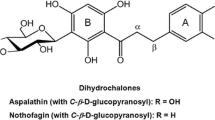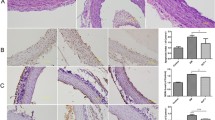Abstract
Vascular inflammation plays a key role in the initiation and progression of atherosclerosis, a major complication of diabetes mellitus. Orientin, a C-glycosyl flavonoid, is known to have anxiolytic and antioxidative activity. In this study, we assessed whether orientin can suppress vascular inflammation induced by high glucose (HG) in human umbilical vein endothelial cells (HUVECs) and mice. Our data indicate that HG markedly increased vascular permeability, monocyte adhesion, the expression of cell adhesion molecules (CAMs), the formation of reactive oxygen species (ROS), and the activation of nuclear factor kappa B (NF-κB). Remarkably, the vascular inflammatory effects of HG were attenuated by pretreatment with orientin. Since vascular inflammation induced by HG is critical in the development of diabetic complications, our results suggest that orientin may have significant benefits in the treatment of diabetic complications and atherosclerosis.






Similar content being viewed by others
REFERENCES
Whiting, D.R., L. Guariguata, C. Weil, and J. Shaw. 2011. IDF diabetes atlas: global estimates of the prevalence of diabetes for 2011 and 2030. Diabetes Research and Clinical Practice 94: 311–321.
Grundy, S.M., I.J. Benjamin, G.L. Burke, et al. 1999. Diabetes and cardiovascular disease: a statement for healthcare professionals from the American Heart Association. Circulation 100: 1134–1146.
Thomas, J.E., and J.M. Foody. 2007. The pathophysiology of cardiovascular disease in diabetes mellitus and the future of therapy. Journal of the Cardiometabolic Syndrome 2: 108–113.
Roglic, G., N. Unwin, P.H. Bennett, et al. 2005. The burden of mortality attributable to diabetes: realistic estimates for the year 2000. Diabetes Care 28: 2130–2135.
Rubino, F., and M. Gagner. 2002. Potential of surgery for curing type 2 diabetes mellitus. Annals of Surgery 236: 554–559.
Day, C. 1998. Traditional plant treatments for diabetes mellitus: pharmaceutical foods. The British Journal of Nutrition 80: 5–6.
Li, G.Q., A. Kam, K.H. Wong, et al. 2012. Herbal medicines for the management of diabetes. Advances in Experimental Medicine and Biology 771: 396–413.
Kumar, S., and A.K. Pandey. 2013. Chemistry and biological activities of flavonoids: an overview. ScientificWorldJournal 2013: 162750.
Dietrych-Szostak, D., and W. Oleszek. 1999. Effect of processing on the flavonoid content in buckwheat (Fagopyrum esculentum Moench) grain. Journal of Agricultural and Food Chemistry 47: 4384–4387.
Soulimani, R., C. Younos, S. Jarmouni, D. Bousta, R. Misslin, and F. Mortier. 1997. Behavioural effects of Passiflora incarnata L. and its indole alkaloid and flavonoid derivatives and maltol in the mouse. Journal of Ethnopharmacology 57: 11–20.
Li, Y.L., S.C. Ma, Y.T. Yang, S.M. Ye, and P.P. But. 2002. Antiviral activities of flavonoids and organic acid from Trollius chinensis Bunge. Journal of Ethnopharmacology 79: 365–368.
Budzianowski, J., G. Pakulski, and J. Robak. 1991. Studies on antioxidative activity of some C-glycosylflavones. Polish Journal of Pharmacology and Pharmacy 43: 395–401.
Lee, W., S.K. Ku, and J.S. Bae. 2013. Emodin-6-O-beta-d-glucoside down-regulates endothelial protein C receptor shedding. Archives of Pharmacal Research 36: 1160–1165.
Bae, J.S., and A.R. Rezaie. 2013. Thrombin inhibits HMGB1-mediated proinflammatory signaling responses when endothelial protein C receptor is occupied by its natural ligand. BMB Reports 46: 544–549.
Kim, T.H., S.K. Ku, I.C. Lee, and J.S. Bae. 2012. Anti-inflammatory functions of purpurogallin in LPS-activated human endothelial cells. BMB Reports 45: 200–205.
Bae, J.S., W. Lee, and A.R. Rezaie. 2012. Polyphosphate elicits proinflammatory responses that are counteracted by activated protein C in both cellular and animal models. J Thromb Haemost 10: 1145–1151.
Lee, J.D., J.E. Huh, G. Jeon, et al. 2009. Flavonol-rich RVHxR from Rhus verniciflua stokes and its major compound fisetin inhibits inflammation-related cytokines and angiogenic factor in rheumatoid arthritic fibroblast-like synovial cells and in vivo models. International Immunopharmacology 9: 268–276.
Bae, J.S., W. Lee, J.O. Nam, J.E. Kim, S.W. Kim, and I.S. Kim. 2014. Transforming growth factor beta-induced protein promotes severe vascular inflammatory responses. American Journal of Respiratory and Critical Care Medicine 189: 779–786.
Lee, W., S.K. Ku, D. Lee, T. Lee, and J.S. Bae. 2014. Emodin-6-O-beta-d-glucoside inhibits high-glucose-induced vascular inflammation. Inflammation 37: 306–313.
Mackman, N., K. Brand, and T.S. Edgington. 1991. Lipopolysaccharide-mediated transcriptional activation of the human tissue factor gene in THP-1 monocytic cells requires both activator protein 1 and nuclear factor kappa B binding sites. The Journal of Experimental Medicine 174: 1517–1526.
Laakso, M. 1999. Hyperglycemia and cardiovascular disease in type 2 diabetes. Diabetes 48: 937–942.
Wardle, E.N. 1994. Vascular permeability in diabetics and implications for therapy. Diabetes Research and Clinical Practice 23: 135–139.
Hamuro, M., J. Polan, M. Natarajan, and S. Mohan. 2002. High glucose induced nuclear factor kappa B mediated inhibition of endothelial cell migration. Atherosclerosis 162: 277–287.
Morigi, M., S. Angioletti, B. Imberti, et al. 1998. Leukocyte-endothelial interaction is augmented by high glucose concentrations and hyperglycemia in a NF-kB-dependent fashion. The Journal of Clinical Investigation 101: 1905–1915.
Boisvert, W.A. 2004. Modulation of atherogenesis by chemokines. Trends in Cardiovascular Medicine 14: 161–165.
Dunlop, M. 2000. Aldose reductase and the role of the polyol pathway in diabetic nephropathy. Kidney International. Supplement 77: S3–S12.
Han, H.J., Y.J. Lee, S.H. Park, J.H. Lee, and M. Taub. 2005. High glucose-induced oxidative stress inhibits Na+/glucose cotransporter activity in renal proximal tubule cells. American Journal of Physiology. Renal Physiology 288: F988–F996.
Rimbach, G., G. Valacchi, R. Canali, and F. Virgili. 2000. Macrophages stimulated with IFN-gamma activate NF-kappa B and induce MCP-1 gene expression in primary human endothelial cells. Molecular Cell Biology Research Communications 3: 238–242.
Uemura, S., H. Matsushita, W. Li, et al. 2001. Diabetes mellitus enhances vascular matrix metalloproteinase activity: role of oxidative stress. Circulation Research 88: 1291–1298.
Kannel, W.B., and D.L. McGee. 1979. Diabetes and cardiovascular disease. The Framingham study. JAMA 241: 2035–2038.
Nannipieri, M., L. Rizzo, A. Rapuano, A. Pilo, G. Penno, and R. Navalesi. 1995. Increased transcapillary escape rate of albumin in microalbuminuric type II diabetic patients. Diabetes Care 18: 1–9.
Tooke, J.E. 1995. Microvascular function in human diabetes. A physiological perspective. Diabetes 44: 721–726.
Gerrity, R.G. 1981. The role of the monocyte in atherogenesis: I. Transition of blood-borne monocytes into foam cells in fatty lesions. The American Journal of Pathology 103: 181–190.
Esposito, C., G. Fasoli, A.R. Plati, et al. 2001. Long-term exposure to high glucose up-regulates VCAM-induced endothelial cell adhesiveness to PBMC. Kidney International 59: 1842–1849.
Lopes-Virella, M.F., and G. Virella. 1992. Immune mechanisms of atherosclerosis in diabetes mellitus. Diabetes 41(Suppl 2): 86–91.
Bae, J.S. 2012. Role of high mobility group box 1 in inflammatory disease: focus on sepsis. Archives of Pharmacal Research 35: 1511–1523.
Kado, S., T. Wakatsuki, M. Yamamoto, and N. Nagata. 2001. Expression of intercellular adhesion molecule-1 induced by high glucose concentrations in human aortic endothelial cells. Life Sciences 68: 727–737.
Hansson, G.K., and P. Libby. 2006. The immune response in atherosclerosis: a double-edged sword. Nature Reviews. Immunology 6: 508–519.
Inoguchi, T., P. Li, F. Umeda, et al. 2000. High glucose level and free fatty acid stimulate reactive oxygen species production through protein kinase C-dependent activation of NAD(P)H oxidase in cultured vascular cells. Diabetes 49: 1939–1945.
ACKNOWLEDGMENTS
This study was supported by the National Research Foundation of Korea (NRF) funded by the Korea government (MSIP) (Grant No. 2013-067053).
Conflict of Interest
The authors declare no conflicts of interest.
Author information
Authors and Affiliations
Corresponding author
Additional information
Sae-Kwang Ku and Soyoung Kwak contributed equally to this work.
Rights and permissions
About this article
Cite this article
Ku, SK., Kwak, S. & Bae, JS. Orientin Inhibits High Glucose-Induced Vascular Inflammation In Vitro and In Vivo . Inflammation 37, 2164–2173 (2014). https://doi.org/10.1007/s10753-014-9950-x
Published:
Issue Date:
DOI: https://doi.org/10.1007/s10753-014-9950-x




